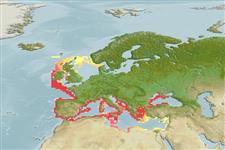Bivalvia |
Mytilida |
Mytilidae
Environment: milieu / climate zone / εύρος βάθους / distribution range
Οικολογία
; εύρος βάθους 125 - 200 m (Αναφ. 2754). Tropical, preferred 16°C (Αναφ. 107945); 61°N - 30°N, 11°W - 36°E
Northeast Atlantic, the Mediterranean and the Black Sea. Introduced to the Arctic, Indian and Pacific Oceans.
Length at first maturity / Μέγεθος / Weight / Age
Γεννητική Ωρίμανση: Lm ? range ? - ? cm Max length : 16.5 cm SHL αρσενικό/απροσδιόριστο; (Αναφ. 109255)
The shell lacks radiating ridges containing three small teeth below the beak. The exterior is often bluish black with the interior portion being dull blue (Ref. 310).
Found in warmer waters (Ref. 95344). Occurs in quiet waters and lives lower in the intertidal zone attached to rock substrates (Refs. 310, 125090). Inhabits muddy and sandy bottoms (Ref. 125090). Smaller individuals move to the outer edge of the colony (Ref. 310). Feeds on a variety of phyto- and zooplankton (Ref. 112108).
Life cycle and mating behavior
Γεννητική Ωρίμανση | Αναπαραγωγή | Γεννοβολία | Eggs | Γονιμότητα | Larvae
Members of the class Bivalvia are mostly gonochoric, some are protandric hermaphrodites. Life cycle: Embryos develop into free-swimming trocophore larvae, succeeded by the bivalve veliger, resembling a miniature clam.
Demir, M. 2003 Shells of mollusca collected from the seas of Turkey. Turkey Journal of Zoology 27:101-140. (Αναφ. 2754)
IUCN Red List Status
(Αναφ. 130435: Version 2025-1)
CITES status (Αναφ. 108899)
Not Evaluated
Not Evaluated
Threat to humans
Human uses
αλιεία: Εμπορικό(ά)
FAO - Υδατοκαλλιέργειες: production, species profile; αλιεία: landings, species profile | FishSource | Η θάλασσα γύρω μας
Εργαλεία
Περισσότερες πληροφορίες
Life cycleΑναπαραγωγήΓεννητική ΩρίμανσηΓονιμότηταΓεννοβολίαEggsEgg developmentLarvae PhysiologyΚατανάλωση οξυγόνου
Human RelatedStamps, coins, misc.
Διαδικτυακές πηγές
Estimates based on models
Preferred temperature
(Ref.
115969): 5.5 - 18, mean 11 (based on 176 cells).
Ελαστικότητα
Υψηλό, ελάχιστος χρόνος για διπλασιασμό πληθυσμού < 15 μήνες (K=0.1-1.82).
Prior r = 0.50, 95% CL = 0.33 - 0.75, Based on 2 data-limited stock assessments.
Fishing Vulnerability
Low vulnerability (20 of 100).
Climate Vulnerability
Moderate to high vulnerability (53 of 100).
Nutrients : Calcium = 149 [71, 228] mg/100g; Iron = 8.53 [1.95, 15.11] mg/100g; Protein = 9.88 [8.64, 11.12] %; Omega3 = 0.313 [0.202, 0.423] g/100g; Selenium = 61 [50, 72] μg/100g; VitaminA = 0 μg/100g; Zinc = 2.04 [0.56, 3.51] mg/100g (wet weight); based on
nutrient studies.
